Low fat butter spread

This low fat butter spread has 22% less fat then butter. Saturday 22nd January 2012, Recipe 20120122
How to make low fat butter spread – an introduction
I have been pondering about the increase in the price of butter over the last few months. Butter prices jumped betweeen August and October 2011 by 25%. It was an overnight jump in prices. I just walked into the supermarkets one day and was shocked to see the new prices for butter. At that point I resolved to find a cheaper substitute without using margarine because I am a self confessed butter addict. Butter is simply too delicious not to be used. It improves a flavour of most recipes and has a wonderful moisturising effect and improves texture to cakes and pastries. I had to find a substitute.
After all that work I had carried out on chocolate mousses I thought I should get back to bread and butter topics beginning with low fat butter spread. If you have been a regular visitor at this website you would know that I do carry out many experiments on cooking and try to improve them as I go along. This time around I had carried out a few experiments on cost reduction of butter and some were hopeless flops and some were just plain horrible. You will understand when I blog about lecithin. This time around the cost reduction turned out to be a low fat butter. Actually, technically, I cannot use the term ‘low fat butter’ and will only be allowed to use the term ‘low fat butter spread’ to distinguish it from butter and because I am not making butter but just modifying it into something else.
I had thought of mixing margarine in butter to lower the cost but then it would have a margarine flavour and the cost reduction would not be that great. Of course that would be the easiest thing to do. A no brainer. Water is the cheapest thing on earth in most countries so I tried mixing water into butter. And that is how I got my cost reduction and as a side benefit it turns out to be a low fat butter spread because water has no calories or cholestrol. Water is amazing, isn’t it?
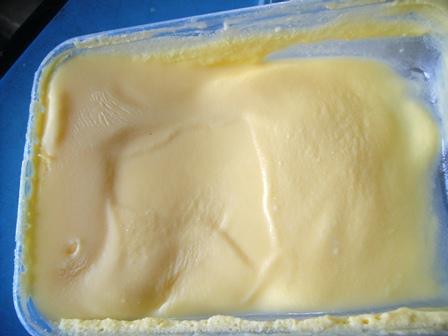
You can observe from the picture it is definitely not easy to get the mix right. This photos was from one of the previous experiments where I had equal amounts of butter and water mixed. The water began to leak out and the low fat butter spread was sloshing around in the container. It could have been due to the type of lecithin I was using was not working properly.
The recipe for the low fat butter spread
| Low fat butter spread | ||||
| Item | Ingredients | Percentage | Weight | Weight |
| (%) | (g) | oz. | ||
| 1 | Butter | 100 | 175 | 6.16 |
| 2 | Water | 30 | 52.5 | 1.848 |
| 3 | Lecithin blend | 1.5 | 2.625 | 0.0924 |
You will notice that I am using a Lecithin blend and not raw unrefined lecithin nor lecithin capsules and not soy lecithin granules. I ran into problems with all three version of lecithin and ended up concocting my own blend of lecithin which I will blog about in the next article. If you are using pure lecithin (eg lecithin capsules sold at the pharmacy) use 0.5% instead of 1.5% as shown in my recipe above.
If you do not know what lecithin is please see Wikipedia , material safety datasheet, lecithin info guide and LECITHIN SUPPLEMENT’S EFFECTIVENESS IN WEIGHT LOSS by Christine Lawhon but non of the mentioned links will explain low fat butter. There are many other emulsifiers on the market that I could have used but I chose Lecithin because of its claimed health benefits.
Photos of the low fat butter spread making process
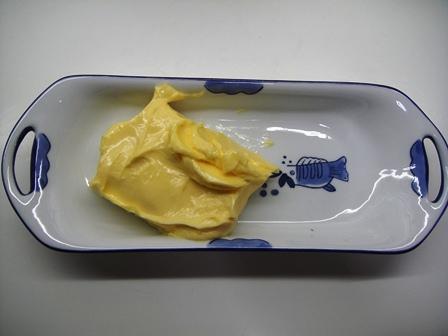
I had used 175g (6.16 oz) for this recipe as that was all the butter I had. There is no other special reason for the odd amount.
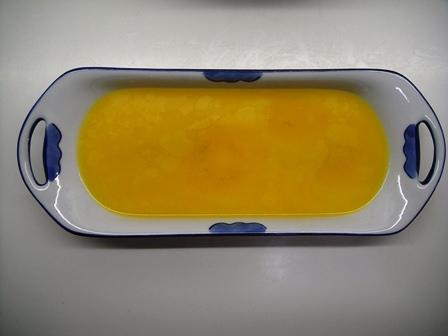
Melt the butter in the microwave oven. You could just put the butter in a pan and heat it up. I used the microwave oven as I tend to have less dishes to wash up later. Do melt it so that it will be easier to mix later on.
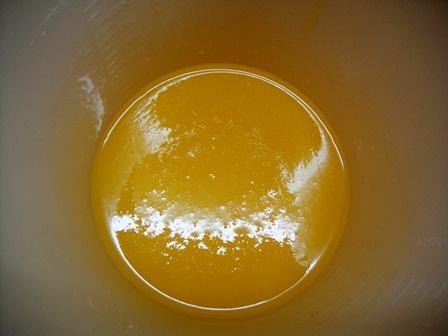
Add the lecithin blend into the melted butter.
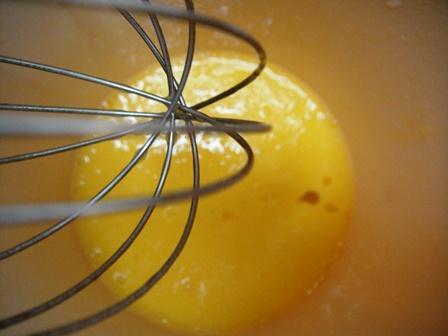
Blend it for a few seconds then add a little water. I added 10% (measured to the weight of butter) water initially – 17.5g ( 0.6oz) then blend again. Add the water a little at a time while blending and this makes it possible to form an emulsion.
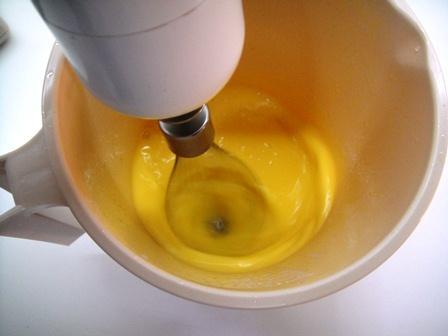
Whisk it well for 30 seconds to a minute. You may notice a slight colour change.
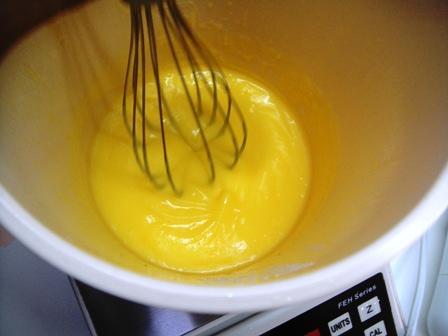
It does become more creamy. It is almost looking like ghee. Add another 17.5g of water and keep mixing for a few more minutes.
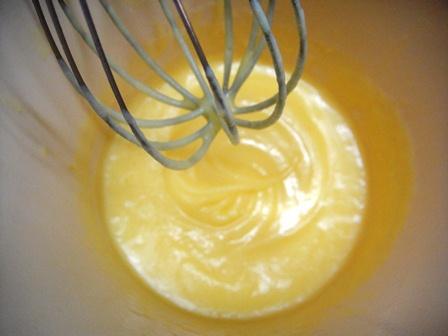
You will notice that the color has lightened and there is more low fat butter spread on the whisk.
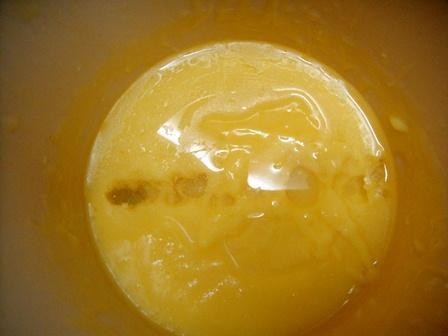
It has thickened and you can see where I had poured the last of the water. There is a ‘hole’ in the low fat butter spread. Keep whisking.
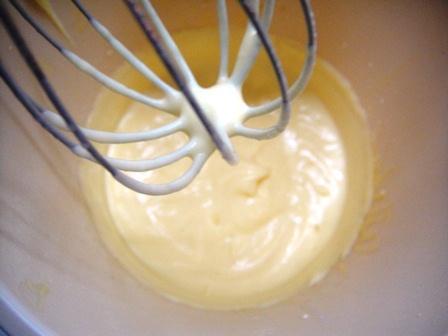
Not only has the low fat butter spread thickened a lot but it has turned almost white in color.
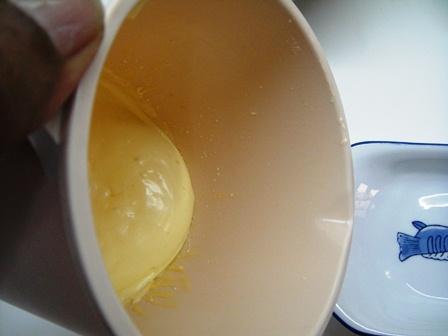
It has thickened so much that it is slow to pour unlike the melted butter. The total whisking time was about 5 minutes or more. I had forgotten to keep track of the time.
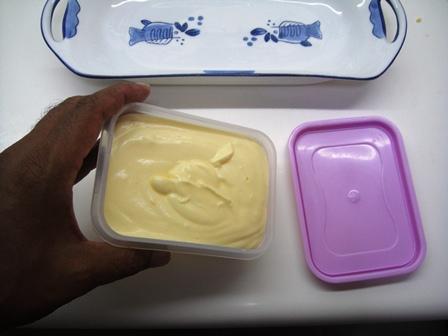
It was quite thick and creamy and when I tilted the container it slowly moved to the end of the container.
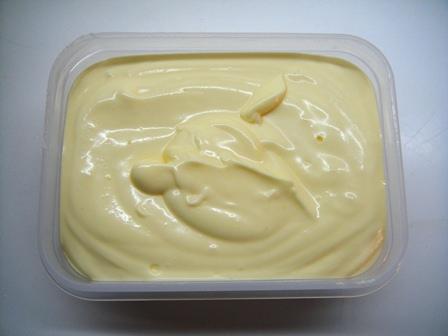
Here is the low fat butter spread ready for ‘shipping’ … to my mom house and for consumption. Even though room temperature is about 28C (82F) to 30C (86F ) it did not melt at room temperature unlike butter.
I did mention it was low fat, right? By 22%, right? Calculate it like this, total weight is 175g butter + 53g water = 228g. Hence the weight of butter as a percentage is 175/228*100 = 77%. That is butter content was reduced by 23% hence the fat content was reduced by 23%.
If you notice that when you spread butter on bread or buns it is usually by volume and not by weight. You SEE how much butter you apply on the bread and you don’t feel how heavy the bread has become when spreading butter. Hence this low fat butter spread will help you lower you fat intake if you are spreading it on bread.
My next article will be on the lecithin blend and how I solved some of the difficulties of using lecithin. I would think it would be very much easier to use a blender then a electric whisk. The low fat butter spread would probably come out smoother. You could try adding more water a little at a time to make it even lower fat content and even cheaper low fat butter spread.
More of lecithin and liposomal vitamin C
8.How to make liposomal vitamin c gel
7.How to make oregano liposomal vitamin c
6.More experiments with liposomal vitamin c
5.how to make lecithin liposomal vitamin C
4.lecithin and carotino oil blend
3.Recovering soy lecithin granules properties – the lecithin blend
2.Comparison of soy lecithin granules, lecithin capsules and raw lecithin
1.How to make low fat butter spread
This article How to make low fat butter spread was researched and written by Peter Achutha
Leave a Reply